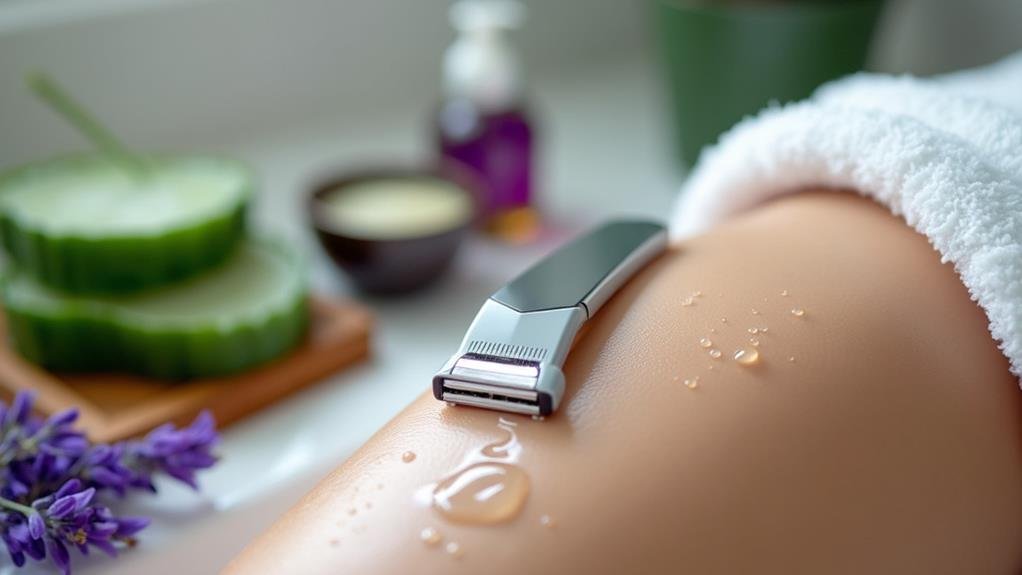
To avoid razor burn while shaving, start by choosing the right razor and ensuring it has sharp, clean blades. Use a quality shaving cream tailored to your skin type—look for natural ingredients that soothe. Before shaving, prepare your skin with warm water and exfoliate to minimize irritation. During shaving, use short, gentle strokes in the direction of hair growth and rinse the blade frequently. After shaving, rinse your face with cool water to close pores and apply a soothing moisturizer. Maintain your razor and consider alternative hair removal methods for less irritation, allowing you to explore further options for smoother skin.
Key Takeaways
- Choose the right razor type and ensure blades are sharp to reduce friction and irritation during shaving.
- Use a quality shaving cream tailored to your skin type, focusing on natural ingredients for better lubrication and protection.
- Prepare skin by cleansing and exfoliating to remove dirt and dead skin cells, enhancing the shaving process.
- Master your shaving technique by using short strokes in the direction of hair growth, applying light pressure, and rinsing the blade frequently.
- After shaving, rinse with cool water, apply soothing aftershave products, and moisturize to calm the skin and prevent irritation.
Choose the Right Razor
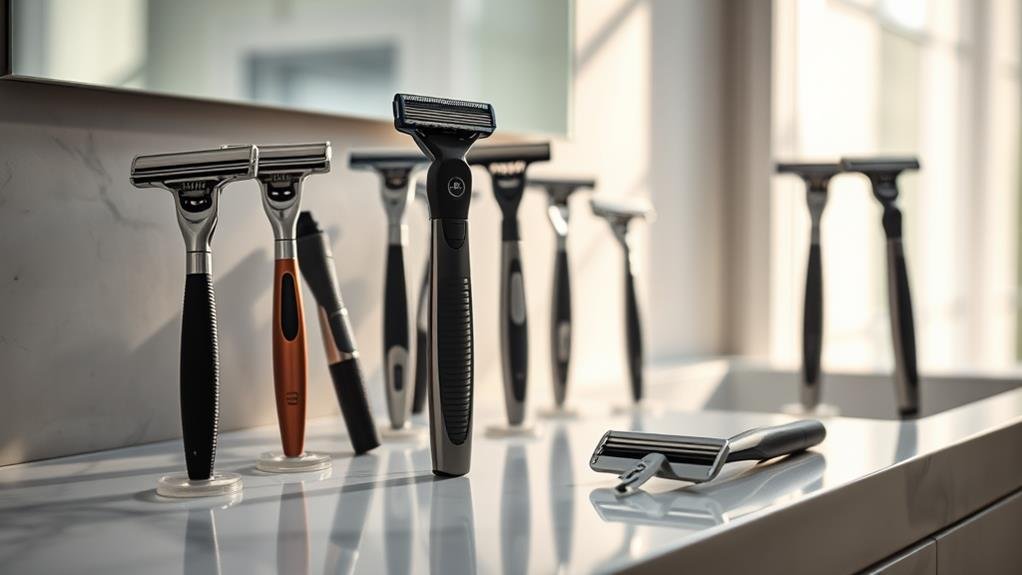
When it comes to avoiding razor burn, selecting the right razor is essential. You should consider different razor types, as each offers distinct advantages and disadvantages.
For instance, cartridge razors are convenient and often equipped with multiple blades, which can provide a close shave. However, they may not always accommodate your skin's sensitivity.
Safety razors, on the other hand, allow for greater control and typically feature single blades, reducing the risk of irritation. If you prefer an electric razor, it can minimize direct skin contact, but you might sacrifice some closeness in the shave.
Regardless of your choice, blades quality is paramount. Dull blades can tug at hair, leading to increased friction and irritation, which directly contributes to razor burn. Invest in high-quality blades, and replace them regularly to ensure a smooth shave.
Ultimately, finding the right razor aligns with your shaving goals and skin type. Pay attention to how your skin reacts to different razors and adjust your choice accordingly.
That way, you can enjoy a comfortable and irritation-free shaving experience.
Use Quality Shaving Cream
Using quality shaving cream is essential for preventing razor burn.
Look for products that contain natural ingredients, as these can soothe and protect your skin.
Additionally, consider your specific skin type to choose a formulation that will work best for you.
Choose Natural Ingredients
Choosing natural ingredients in your shaving cream can significantly reduce the risk of razor burn. When you opt for products that contain natural oils and soothing balms, you're not only prioritizing your skin's health but also enhancing your shaving experience.
Natural oils, such as jojoba and coconut, provide excellent lubrication, allowing the razor to glide smoothly over your skin. This reduces friction and minimizes the likelihood of irritation.
Soothing balms, derived from botanical sources, further help calm inflamed skin. Ingredients like aloe vera and chamomile have anti-inflammatory properties that soothe any potential redness or discomfort. By selecting a shaving cream formulated with these natural components, you're empowering yourself to achieve a closer shave without sacrificing comfort.
Moreover, many commercial shaving creams contain synthetic ingredients that can exacerbate skin sensitivity. By choosing products made with natural ingredients, you're taking an active step towards a healthier grooming routine.
This conscious choice not only supports your skin's integrity but also aligns with a desire for a more natural lifestyle. Ultimately, using quality shaving cream with natural ingredients can lead to a smoother, more enjoyable shaving experience.
Consider Skin Type
Understanding your skin type is crucial in selecting a quality shaving cream that minimizes the risk of razor burn. If you have sensitive skin, look for creams that are fragrance-free and contain soothing ingredients like aloe vera or chamomile.
For those with oily skin, opt for lightweight formulas that won't clog pores while helping to control excess oil. Dry skin requires a rich, hydrating cream that enhances skin hydration and prevents irritation.
Combination skin benefits from a balanced shaving cream that addresses both oily and dry areas. If you're acne-prone, choose non-comedogenic products to avoid breakouts, while aging skin may need creams infused with antioxidants to maintain skin elasticity and reduce sensitivity.
Normal skin can generally tolerate a variety of products, but it's still wise to select one that supports your overall skin care routine.
Ultimately, ensuring that your shaving cream aligns with your specific skin type can significantly reduce skin sensitivity and prevent razor burn.
Prep Your Skin Properly
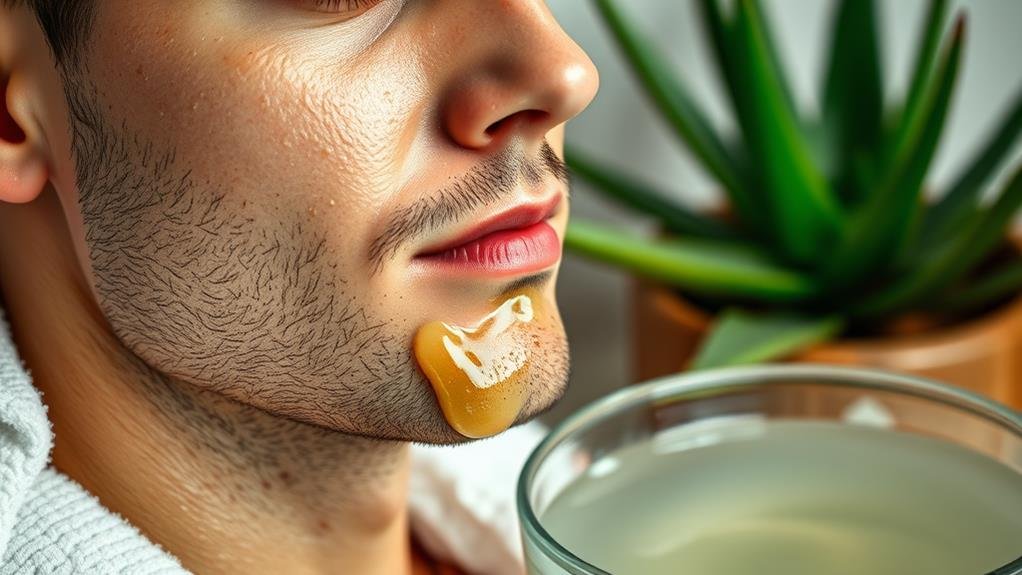
To achieve a smooth shave and minimize razor burn, you must prep your skin properly.
Start by cleansing your face to remove dirt and oil, then exfoliate to eliminate dead skin cells for a smoother surface.
Using warm water throughout this process helps to open up your pores, making it easier for the razor to glide over your skin.
Cleanse Before Shaving
How can you ensure a smoother shave and reduce the risk of razor burn? The answer lies in a solid pre-shave routine that starts with cleansing your skin. Before you pick up your shaving tools, it's essential to wash your face with a gentle cleanser. This step removes dirt, oil, and dead skin cells, setting the stage for a flawless shaving experience.
Cleansing your skin not only helps to unclog pores but also softens facial hair, making it easier for your razor to glide smoothly. Use warm water to open up your pores, as the heat allows for a deeper cleanse and further softening of the hair.
After washing, pat your skin dry with a clean towel, avoiding any rough movements that could irritate your skin.
Incorporating cleansing into your pre-shave routine is crucial for minimizing irritation and achieving that desired smoothness. By taking these steps, you create an optimal environment for shaving, significantly reducing the chances of razor burn.
A little preparation goes a long way, ensuring your skin stays healthy and irritation-free.
Exfoliate for Smoothness
Exfoliating your skin before shaving plays a crucial role in achieving a smooth finish while preventing razor burn. By removing dead skin cells and unclogging pores, exfoliation enhances the effectiveness of your shave and minimizes irritation.
You can employ various scrub techniques, such as gentle circular motions with your fingertips or using a soft washcloth, to effectively slough off dead skin.
Additionally, consider incorporating exfoliating tools, like a body brush or a loofah, into your routine. These tools can provide a deeper exfoliation, ensuring that your skin is prepped properly for shaving. Aim to exfoliate at least two to three times a week, especially in areas prone to razor burn.
When choosing an exfoliant, look for products with natural ingredients like sugar or salt, which offer a gentle yet effective scrub. Avoid harsh chemical exfoliants, as they may irritate your skin further.
Use Warm Water
Proper skin preparation continues with the use of warm water, which plays a significant role in minimizing razor burn. When you use warm water, you enhance blood circulation and open up your pores. This process allows for better hair removal and reduces the risk of irritation.
The warm water benefits extend beyond mere comfort; it also helps to soften the hair, making it easier for the razor to glide smoothly across your skin.
Hydration is another critical factor. By using warm water, you ensure your skin is adequately hydrated, which is vital for maintaining its elasticity and resilience. Well-hydrated skin is less likely to experience the tugging and pulling that can lead to razor burn.
Additionally, consider taking a warm shower or applying a warm, damp towel to your face before shaving. This step will further prepare your skin and enhance the overall shaving experience.
Incorporating warm water into your shaving routine is a simple yet effective strategy. It not only helps to minimize discomfort but also empowers you to achieve a smooth, irritation-free shave.
Master Your Shaving Technique
Mastering your shaving technique can significantly reduce the risk of razor burn. Begin by selecting high-quality shaving products tailored to your skin sensitivity. A proper shaving cream or gel creates a protective barrier, minimizing friction during the shave. Apply it generously and allow it to sit for a minute to soften the hair and hydrate the skin.
When you start shaving, use a sharp, clean razor. Dull blades tug at hair rather than cutting it smoothly, which can lead to irritation and discomfort. Maintain a light touch; pressing too hard can damage sensitive skin. Use short, gentle strokes, and avoid going over the same area multiple times.
Rinse the blade frequently to remove hair and cream buildup, ensuring a smooth glide.
After shaving, rinse your face with cool water to close the pores and apply a soothing aftershave product designed for sensitive skin. This will help calm any irritation that may arise.
Shave in the Right Direction
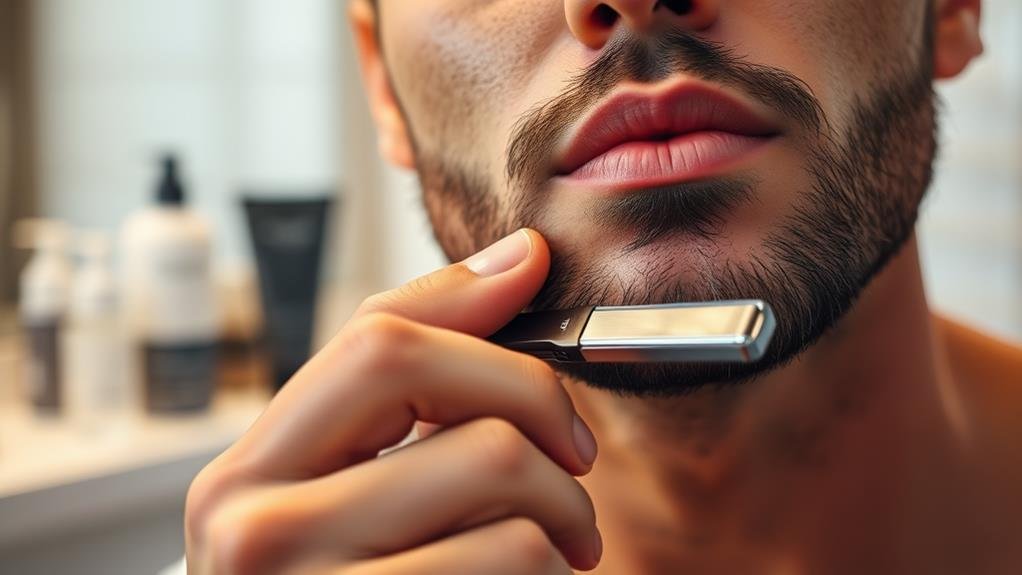
To minimize razor burn, it's crucial to shave in the direction of hair growth.
This approach reduces irritation and helps prevent ingrown hairs.
Additionally, using gentle pressure while shaving can further enhance your comfort and skin health.
Follow Hair Growth Direction
Shaving against the direction of hair growth can lead to irritation and discomfort, commonly resulting in razor burn. To achieve a smoother shave and minimize irritation, it's essential to follow the natural growth direction of your hair. This technique varies depending on your individual hair types, so understanding your unique pattern is crucial.
Here are three key practices to consider:
- Identify Hair Growth Patterns: Before you start shaving, take a moment to observe which direction your hair grows. This can differ across various areas of your body and among different hair types.
- Use Appropriate Shaving Tools: Select high-quality shaving tools suited for your hair type. For coarse hair, consider a razor designed for a closer shave. For finer hair, a gentler tool may suffice.
- Shave with the Grain: Begin your shave by moving the razor in the direction your hair grows. This reduces the risk of ingrown hairs and irritation, allowing for a more comfortable shaving experience.
Use Gentle Pressure Techniques
Using gentle pressure while shaving is crucial for minimizing irritation and preventing razor burn. Many people believe that pressing harder will result in a closer shave, but this is one of the prevalent shaving myths.
In reality, applying excessive pressure can lead to increased skin sensitivity, cuts, and, ultimately, razor burn.
To achieve optimal results, hold your razor lightly and let the blade do the work. A light touch allows the blade to glide smoothly over your skin, reducing friction and irritation.
You should also maintain a steady hand and use short strokes, following the direction of hair growth. This approach not only helps in achieving a cleaner shave but also minimizes the risk of ingrown hairs, which can exacerbate skin sensitivity.
Rinse With Cool Water
How can rinsing with cool water enhance your shaving experience? After you've finished shaving, rinsing your skin with cool water provides immediate cooling effects that can significantly reduce irritation. The soothing properties of cool water help to calm the skin, minimizing the risk of razor burn.
Here are three key benefits of this practice:
- Reduces Inflammation: The cool temperature constricts blood vessels, which can decrease redness and swelling, providing instant relief to your freshly shaved skin.
- Closes Pores: Rinsing with cool water helps close your pores, reducing the chance of dirt and bacteria entering, which can lead to breakouts or infections.
- Enhances Comfort: The refreshing sensation of cool water not only feels good but also prepares your skin for any post-shave products, creating a comfortable foundation for the next steps in your grooming routine.
Incorporating a rinse with cool water into your shaving process is a simple yet effective strategy. By utilizing these cooling effects and soothing properties, you can enjoy a more pleasant and irritation-free shaving experience.
Moisturize After Shaving

After rinsing with cool water, applying a moisturizer is a vital step in your post-shaving routine. This action not only enhances post-shave hydration but also plays a crucial role in skin barrier protection.
Shaving can strip your skin of its natural oils, leading to dryness and irritation. A quality moisturizer replenishes moisture and helps restore the skin's protective barrier, reducing the risk of razor burn.
Choose a moisturizer that contains soothing ingredients like aloe vera, hyaluronic acid, or chamomile. These components promote healing and calm any irritation.
When applying the moisturizer, do so gently, using upward strokes to encourage absorption and enhance circulation.
It's essential to apply the moisturizer within minutes of shaving to lock in hydration and maximize its effectiveness. This practice can prevent the skin from becoming flaky or tight, providing a smooth, comfortable feel.
Avoid Shaving on Dry Skin
Shaving on dry skin can lead to increased friction, resulting in irritation and razor burn. To maintain a healthy skin barrier and ensure a smooth shaving experience, prioritize hydration importance.
Here are three key practices to follow:
- Prep Your Skin: Always hydrate your skin before shaving. Use warm water to soften the hair and open up pores, which reduces resistance during shaving.
- Use a Quality Shaving Cream: Opt for a moisturizing shaving cream or gel that provides a protective layer. This helps to further reduce friction and keeps your skin hydrated throughout the process.
- Shave After a Shower: Shaving after a warm shower allows steam to hydrate your skin effectively. The moisture helps in softening the hair, making it easier for the razor to glide smoothly, minimizing the risk of irritation.
Replace Blades Regularly
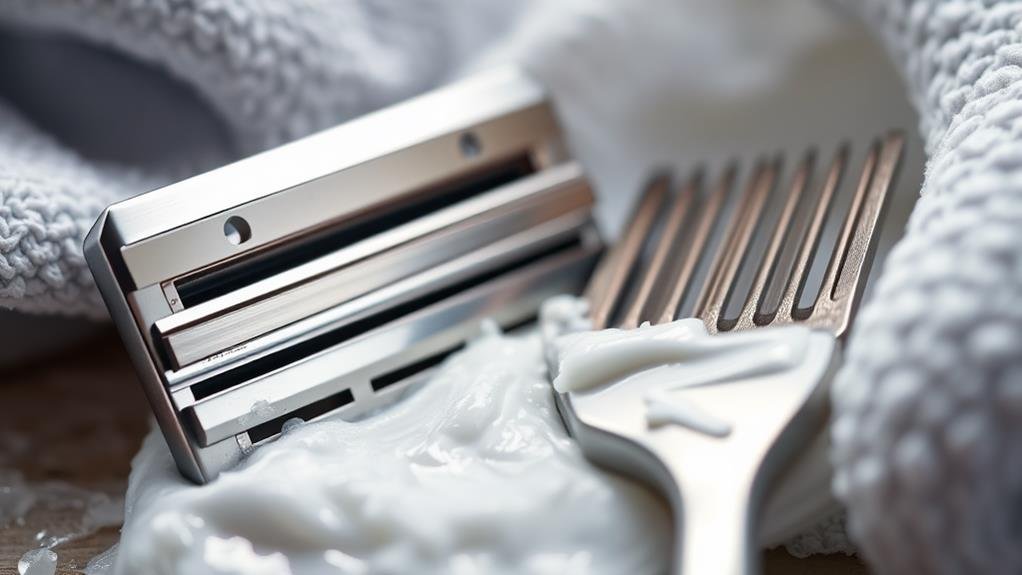
Regularly replacing razor blades is crucial for preventing razor burn and ensuring a comfortable shaving experience. Dull blades tug at your skin rather than glide smoothly, increasing irritation and the likelihood of razor burn. To maintain optimal performance, you should replace your blade after about five to seven uses, or sooner if you notice any signs of dullness.
Proper blade storage plays a significant role in maintaining blade hygiene. After each shave, rinse your blade thoroughly to remove hair and shaving cream. Allow it to dry completely to prevent moisture buildup, which can lead to rust and bacteria growth.
Store your blades in a dry, clean area to protect them from contaminants. You should also consider using a blade guard to shield the edge when not in use. This helps maintain sharpness and reduces the risk of accidental cuts.
Consider Alternative Hair Removal
If you're struggling with persistent razor burn, it may be time to explore alternative hair removal methods. These techniques can provide lasting results while minimizing irritation and discomfort.
- Laser Hair Removal: This method uses concentrated light to target hair follicles, leading to permanent hair reduction. After a series of sessions, many people experience smoother skin without the hassles of shaving or the pain associated with traditional hair removal methods.
- Waxing Alternatives: If you prefer not to shave but want to avoid the irritation that comes with traditional waxing, consider products like sugar wax or hard wax. These alternatives often cause less discomfort and can effectively remove hair from the root.
- Depilatory Creams: These creams chemically dissolve hair, allowing for easy removal without the need for blades. It's essential to choose a formula designed for your skin type to prevent adverse reactions.
Exploring these options could offer you the freedom to enjoy hair removal without the frustration of razor burn.
Conclusion
By following these tips, you can significantly reduce the risk of razor burn and enjoy a smoother shave. Did you know that nearly 60% of people experience some form of razor irritation? By choosing the right tools and techniques, you not only enhance your comfort but also improve the overall quality of your shave. Remember, proper skin prep and aftercare are just as crucial as the shave itself. Prioritize your skin health for a better grooming experience.
